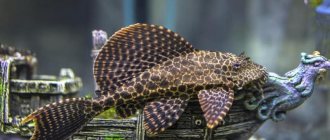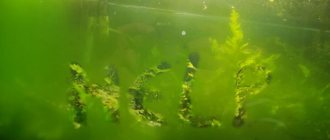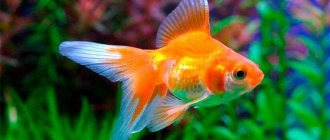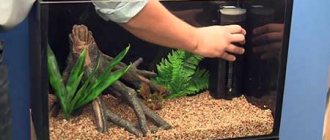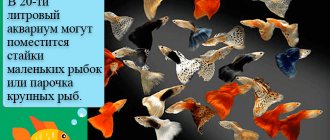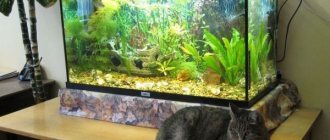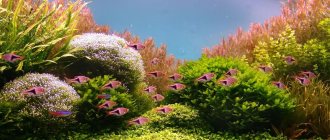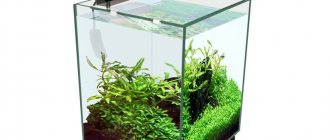The Siamese algae eater or crossocheilus siamensis lives mainly in Asian countries: Thailand, Sumatra, Indonesia. An abbreviation for Siamese Algae Eater is also often found - SAE, not to be confused with SAE, the Chinese algae eater (gerinocheilus). Natural habitat is streams and small rivers with fast currents and rocky or sandy bottoms. Algae growing on snags and submerged tree roots are the basis of the fish’s diet.
It appeared in Russia in 1962, and since 1970 it has been valued by aquarists for its food preferences. Introducing an algae eater into the aquarium eliminates frequent interventions in the ecosystem. The algae-eating fish is a natural cleaner. There is no need to add agents to the water to prevent the proliferation of unwanted vegetation.
Description
The Siamese algae eater belongs to the carp family. The body is oblong gray-brown. The belly is lighter than the back. There is a black jagged stripe along the side.
This breed requires a spacious aquarium of 50 liters per fish.
The algae eater is the only fish that successfully fights blackbeard (parasitic algae).
In nature, adult individuals reach a height of 15 cm, in aquariums they are often 8–10 cm.
Siamese algae eater and false siamese algae eater
A true crosstail coexists with a false Siamese in the same body of water. Juveniles of both species form joint schools. Often pet stores sell both together. SAE is confused with the flying fox. The breed is distinguished by its mustache, fins, color and behavior.
Comparison table between real and false algae eaters based on external characteristics:
| Parameter | Siamese algae eater | flying fox |
| Black stripe on the side | captures the rear fin, zigzag | does not go into the fin, flat |
| Strip around the mouth | clear | blurry |
| Fins | transparent | yellow |
| Mustache | 2 | 4 |
| Degree of aggressiveness | low | high |
| Rest | does not use pectoral fins | rest on the tail, lower and pectoral fins |
| Scales on the back | each with a black border creates a mesh pattern | evenly colored |
The antennae are difficult to see when moving. In a stressful situation, algae-eating fish lighten up and a stripe is clearly visible, which in the original fish goes onto the fin, but in the false Siamese it ends before the start.
The main difference between the Siamese algae eater is its feeding habits.
Neither the Siamese flying fox, nor Crossocheilus langei, nor Crossocheilus atrilimes, sold as SAE, eat algae to the same extent, but they will destroy aquarium mosses.
Appearance of the Siamese algae eater
This is a small fish that has an elongated body of silver color. Transparent small fins make the fish hyperactive.
The decoration is a dark stripe. It stretches across the entire body, ending at the tail, and is its characteristic feature.
The stripe has serrations, and the fish itself has small whiskers, which indicate that it belongs to the carp family.
Content
Temperament – peaceful, accommodating. Carp, which are very active by nature, often jump out of the aquarium. To avoid killing your fish, use a lid or plants to cover the surface of the water.
Water parameters
| acidity | 6.5–8 pH |
| rigidity | 5–20 dGH |
| water temperature | 24–26 degrees |
The aquarium fish Siamese algae eater prefers cleanliness and freshness. Once a week, 1/3 of the water volume is changed.
Aquarium
The size of the aquarium for keeping Gyrinocheilus siamese is from 100 liters. The shape is elongated. The decor is moderate so that the fish can move freely.
Priming
Siamese algae eaters in an aquarium collect settled algae from the bottom. Use dense sand or pebbles as soil. Similar substrates are sold in pet stores. The soil needs to be siphoned about once a month to remove food debris.
If you collected the stones yourself, bake them on a baking sheet or boil them before placing them in the aquarium to avoid pests.
Lighting
Natural sparse or artificial lighting is suitable for the Siamese algae eater.
Shield the aquarium from direct sunlight with curtains and indoor plants. For artificial lighting, choose fluorescent lamps with a power of 0.5 W/l.
Fish need 12 hours of daylight.
Equipment
In nature, algae eaters live in bodies of water with fast currents. The water in them is clean and oxygenated. In an aquarium, filtration and increased aeration are constantly necessary. Choose powerful devices, otherwise the fish will feel uncomfortable and may get sick.
Plants
Plants with dense, large leaves are suitable for planting in an aquarium. The fish will rest on them. When disembarking, leave enough space to move around.
Riccia and duckweed on the surface will prevent the SAE algae eater from jumping out of the aquarium.
Mosses are the only plant not suitable for growing with this breed. Any plant species that resemble algal growths will be destroyed.
With enough food, carps do not damage plants.
General information
Siamese Algae Eater (Crossocheilus siamensis) or SAE (Siamese Algae Eater) is a freshwater fish from the family Cyprinidae. This family also contains carps, which are close relatives.
The fish are native to Southeast Asia, including Thailand and Malaysia, but are now bred all over the world for sale to aquarists. The reason they have become so popular is because they are one of the best algae eaters available. The fish move around a lot, so they quickly clean the entire tank.
But like all other aquatic organisms, algae eaters produce waste. If the aquarium is overcrowded, then it will not be possible to get rid of algae with the help of algae eaters, and the aquarium itself will become even dirtier over time.
Compatibility
The algae-eating catfish is peaceful and gets along with active fish and most aquarium inhabitants.
Incompatible:
- Labeo two-color. The fight for territory between these related breeds leads to the death of fish.
- Veils. Algae eaters bite their fins.
- Cichlids. SAE activity bothers them during spawning.
Schooling fish. They require the company of 3–8 individuals of their own species.
View this post on Instagram
Rasbora Sawbwa Resplendens e Comedor de Alga Siamês Verdadeiro! Lindos para o seu aqua plantado. Disponíveis em www.ecoanimal.com.br #rasbora #sawbwa #Aquanimal #crossocheilus
A post shared by Aquanimal (@aquanimal_insta) on Jun 19, 2021 at 5:42pm PDT
Two males, when kept together, injure each other. If you want several fish, get one boy and a bunch of girls.
Feeding
In nature, food consists mostly of algae and less of live food. With age, the proportions change and adults consume more protein than plant foods. There is less vegetation in the aquarium. Feed your pet live, artificial and frozen food.
Feed your fish once a day.
Nutrition should be balanced and varied. The main food remains algae. Add vegetables to your diet after scalding them with boiling water.
Fish eat:
- cucumbers;
- zucchini;
- salad;
- spinach.
Pet stores sell ready-made mixtures for carp.
Animal food is necessary to support the growth of algae eaters. Suitable food:
- cyclops;
- Daphnia;
- bloodworm;
- tubifex
When catching food yourself, there is a possibility of introducing bacteria. An alternative is frozen food. It undergoes heat treatment to remove all harmful components. Before giving frozen food to the fish, remove it from the refrigerator and leave it for 15 minutes. Store at -18 degrees. Give as much food as your pets will eat in 3 minutes, otherwise the risk of water contamination will increase.
Overfed Siamese algae eaters are indifferent to algae and therefore do not clean the aquarium. Keep SAE in a semi-starved state. Juveniles in the role of orderlies are the most active.
Breeding
It is unlikely that you will be able to breed these fish yourself. But little is currently known about how to breed them in home aquariums. They are known to reproduce only on farms with the help of hormones.
Whether you're new to aquarium keeping or have been doing it for years, you should have no problem keeping your Siamese algae eaters happy and healthy.
They are peaceful and hardy, so they are less likely to fall victim to rookie mistakes.
If your aquarium has plants, peaceful fish and enough free space, they will live and enjoy themselves. In turn, your aquarium will become cleaner and more active.
Reproduction
Does not reproduce in aquarium conditions. Caviar is extremely vulnerable to fungi and infections. The fry die at the maturation stage.
They often sell wild-caught fish. Despite the impossibility of breeding, the fish is often found on the shelves of pet stores.
Sex differences
Weak sexual dimorphism. The female is larger and more rounded than the male.
When purchasing, consult a specialist; it is difficult to notice the difference with the naked eye.
Adviсe
To keep your fish from getting sick and live 10 years, follow the rules:
Keep your aquarium clean. Monitor the condition of the filter and aerator. Cover the container with a lid or plants. When purchasing, pay attention to the characteristic features. The flying Siamese fox and real Siamese are very similar. Siamese algae eaters are easy to keep, get along with almost any neighbors and perform a sanitary role, helping the owner keep the aquarium clean
Suitable for beginner aquarists. They do not reproduce in captivity, so you will have to buy new fish at a pet store
Siamese algae eaters are easy to keep, get along with almost any neighbors and perform a sanitary role, helping the owner keep the aquarium clean. Suitable for beginner aquarists. They do not breed in captivity, so you will have to buy new fish at a pet store.
Previous FishesBlack knife or black prince - is it an aquarium fish? Next FishHomelands of popular aquarium fish
Diseases and treatment
Little susceptible to disease. The immune system is strong. To maintain fish health, ensure the cleanliness and quality of the food.
Fungi and bacteria that get into the water, coupled with the decomposition of food residues, will harm the health of pets.
Symptoms of the disease due to non-compliance with the conditions of detention:
- lethargy;
- excessive mobility;
- bulging or reddened eyes;
- bruising in the gill area.
If one or more symptoms are detected, clean the aquarium. Changing the water also helps. If the condition does not improve, use antibiotics.
Diseases are also caused by a fungus that gets to the fish with unprepared food or untreated soil. Place fish with plaque on the body and/or fins in a separate aquarium for quarantine. For treatment, use baths with antibacterial, disinfecting solutions. Before use, consult a specialist to calculate proportions. An error will cause the condition to worsen.
Incorrectly selected lighting fixtures cause burns.
Reviews
Aquarists respond positively to SAE. Main advantages:
- Eliminates the rapid development of algae.
- She is active and interesting to watch.
- Rarely gets sick.
- Low price.
The disadvantages include:
- Inability to reproduce at home.
- Unprepossessing appearance.
Habitat in nature
The SAE species is native to southern Asia. The largest concentrations of representatives of this species can be seen in Thailand, Indonesia, and Sumatra. Prefers fresh water bodies with fast currents and a hard rocky bottom: shallow rivers or streams. It actively reproduces in reservoirs with high water transparency, shallow depth and abundant growth of algae, since this species in its natural habitat feeds exclusively on river vegetation.
